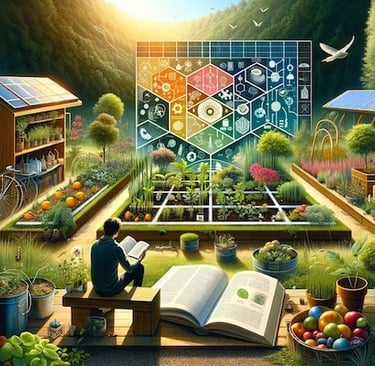
Sustainable Healthy Living: Discover Practical Solutions
Bruce Gibson ND
5 min read


Permaculture Fundamentals: Integrating Science and Philosophy for Sustainable Well-Being
Introduction
Permaculture began as an amalgamation of "permanent agriculture" and "permanent culture," reflecting a system designed to be sustainable, regenerative, and in harmony with nature. Given the current environmental challenges like climate change, soil degradation, and loss of biodiversity, Permaculture offers solutions rooted in principles that mimic natural ecosystems (Mollison & Holmgren, 1978). Permaculture offers a rewarding approach for anyone interested in wellness and sustainable living. It combines thoughtful design with ethical principles, promising a more fulfilling and environmentally responsible lifestyle for the broader community.
The Science Foundations of Permaculture
Soil Health
Soil is the backbone of any agricultural system, and its health determines crop yield, nutritional quality, and sustainability. In conventional agriculture, frequent tilling and excessive use of chemical fertilisers have led to soil erosion and nutrient loss (Montgomery, 2007). Permaculture, on the other hand, advocates for no-till gardening and polyculture, which enrich the soil with organic matter and preserve its structure (Rhodes, 2012). Research indicates that healthier soil supports a more vibrant ecosystem of beneficial microorganisms and insects, which contributes to natural pest control and soil fertility (Doran & Zeiss, 2000).
Water Conservation
Water is another critical resource that Permaculture aims to manage sustainably. Techniques like swales and keyline design optimize the use of water in the landscape, reducing the need for irrigation (Yeomans, 1954). A study by Zhou et al. (2010) revealed that sustainable water management practices, such as those advocated in Permaculture, can significantly reduce water runoff and soil erosion.
Biodiversity
One of the most compelling scientific merits of Permaculture is its emphasis on biodiversity. Traditional monocultures are susceptible to diseases and pests, often requiring chemical interventions (Altieri, 1999). In contrast, Permaculture systems prioritize a diversity of plant species, leading to increased resilience and reduced disease prevalence (Jackson & Jackson, 2002).
Applications in Modern Agriculture
Agroforestry
Agroforestry, the practice of integrating trees and shrubs into crop and animal systems, has gained attention as a viable Permaculture practice (Nair, 1993). These systems have demonstrated higher crop yields, improved soil fertility, and increased biodiversity, substantiating Permaculture’s claims for sustainability (Jose, 2009).
Urban Farming
Urban environments, often thought of as disconnected from nature, are now becoming fertile grounds for Permaculture. Vertical farming, rooftop gardens, and community plots incorporate Permaculture principles to produce food sustainably while reducing the urban heat island effect and mitigating climate change (Despommier, 2010).
Nutritional Abundance
For nutrition aware and health-conscious individuals, Permaculture offers a treasure trove of nutrient-dense foods. By incorporating a wide variety of fruits, vegetables, and herbs, Permaculture systems can provide a more nutritionally balanced diet, high in essential vitamins, minerals, and phytonutrients (Slavin & Lloyd, 2012).
Connecting with Nature
Biophilia, the innate human attraction to nature, has been linked to reduced stress, improved mental well-being, and even increased longevity (Kellert & Wilson, 1993). By encouraging interaction with natural systems, Permaculture promotes wellness through stress reduction and mental clarity.
Herbal and Medicinal Plants
If, like me, you have an interest in herbalism, you can appreciate the integration of medicinal plants in Permaculture designs. Herbs like echinacea, lavender, and chamomile can be incorporated into a Permaculture garden, providing aesthetic value and potential health benefits (Bone & Mills, 2013).
Mindfulness and Permaculture: A Symbiotic Relationship
Permaculture is often viewed solely through the lens of agricultural practice, but its principles can also extend to mindfulness and personal well-being. This idea aligns with your interests in connecting with higher human potential. Mindfulness and Permaculture share common values, such as intentionality, observation, and a systems approach to thinking (Kabat-Zinn, 1990).
Intentionality
In both mindfulness and Permaculture, intentionality plays a key role. Mindfulness teaches us to act with intent and be present in our actions. This concept closely mirrors the Permaculture principle of "Observe and Interact," encouraging us to engage mindfully with our environment (Mollison, 1988). Mindful eating, for example, can be practised in a Permaculture-based lifestyle by appreciating the seasonality and local sourcing of foods (Pollan, 2008).
Observation
Just as mindfulness urges us to observe our thoughts, Permaculture encourages keen observation of the land and its elements. Observation skills are not just essential for effective Permaculture design but can also be applied to internal self-awareness, mental health, and overall well-being (Siegel, 2007).
Systems Thinking
Both disciplines also utilise a systems approach, understanding components not in isolation but as interconnected parts of a whole (Capra, 1996). Systems thinking allows for a broader understanding of wellness, incorporating not only physical health but also emotional, social, and environmental well-being.
Permaculture in Online Education and Community Building
Permaculture can be a rich subject to explore in a digital learning environment. Interactive courses can enable individuals to learn and apply Permaculture principles right in their backyards or communities.
Community Building
Permaculture offers ample opportunities for community building. Online platforms can facilitate discussions on local seed exchanges, community gardening projects, and collaborative efforts in sustainable living. Given the strong community ethos in places like Crystal Waters Ecovillage, these insights can be especially valuable.
The Future Outlook: Permaculture and Global Challenges
As we face the 21st-century challenges of climate change, resource depletion, and public health crises, Permaculture offers a beacon of hope for a more sustainable and healthy future. Its principles are universal, capable of being applied in various cultural and climatic conditions, making it a globally relevant movement (Ferguson & Lovell, 2014).
By aligning our lifestyle with Permaculture principles, we not only contribute to environmental sustainability but also foster personal wellness. As you look forward to a happy and healthy future, incorporating Permaculture into your life can serve as a vehicle for positive change.
Conclusion
Permaculture is more than a set of agricultural techniques; it's a philosophy of living in harmony with nature, advocating for a sustainable, healthier future. Its scientific foundations and applications prove it as a viable alternative to conventional agriculture. Moreover, its emphasis on biodiversity, soil health, and water conservation aligns well with sustainable living and wellness goals.
For anyone invested in promoting a healthier lifestyle and sustainable practices, Permaculture is not merely a subject of academic interest but a practical pathway to a happier, healthier life.
References
Altieri, M. A. (1999). The ecological role of biodiversity in agroecosystems. Agriculture, Ecosystems & Environment, 74(1-3), 19-31.
Bone, K., & Mills, S. (2013). Principles and Practice of Phytotherapy. Churchill Livingstone.
Doran, J. W., & Zeiss, M. R. (2000). Soil health and sustainability: managing the biotic component of soil quality. Applied Soil Ecology, 15(1), 3-11.
Despommier, D. (2010). The Vertical Farm: Feeding the World in the 21st Century. Thomas Dunne Books.
Jackson, W., & Jackson, L. (2002). Natural Systems Agriculture: A Truly Radical Alternative. Agriculture, Ecosystems & Environment, 88, 111-117.
Jose, S. (2009). Agroforestry for ecosystem services and environmental benefits: an overview. Agroforestry Systems, 76(1), 1-10.
Kellert, S. R., & Wilson, E. O. (Eds.). (1993). The Biophilia Hypothesis. Island Press.
Mollison, B., & Holmgren, D. (1978). Permaculture One: A Perennial Agriculture for Human Settlements. Transworld Publishers.
Montgomery, D. R. (2007). Dirt: The Erosion of Civilizations. University of California Press.
Nair, P. K. R. (1993). An Introduction to Agroforestry. Kluwer Academic Publishers.
Rhodes, C. J. (2012). Feeding and healing the world: through regenerative agriculture and permaculture. Science Progress, 95(4), 345-446.
Slavin, J. L., & Lloyd, B. (2012). Health benefits of fruits and vegetables. Advances in Nutrition, 3(4), 506-516.
Yeomans, P. A. (1954). The Keyline Plan. Yeomans Publishing.
Zhou, M., Butterbach-Bahl, K., Vereecken, H., & Brüggemann, N. (2010). A meta-analysis of soil water conservation and runoff and soil loss reduction by conservation agriculture. Soil Use and Management, 26(2), 147-155.
Capra, F. (1996). The Web of Life: A New Scientific Understanding of Living Systems. Anchor Books.
Ferguson, R. S., & Lovell, S. T. (2014). Permaculture for agroecology: design, movement, practice, and worldview. A review. Agronomy for Sustainable Development, 34(2), 251-274.
Kabat-Zinn, J. (1990). Full Catastrophe Living. Delta.
Mollison, B. (1988). Permaculture: A Designer’s Manual. Tagari Publications.
Pollan, M. (2008). In Defense of Food: An Eater's Manifesto. Penguin Books.
Siegel, D. J. (2007). The Mindful Brain: Reflection and Attunement in the Cultivation of Well-Being. W. W. Norton & Company.
Let's talk about it...

